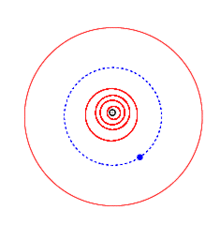9916 Kibirev
| Discovery [1] | |
|---|---|
| Discovered by | N. Chernykh |
| Discovery site | Crimean Astrophysical Obs. |
| Discovery date | 3 October 1978 |
| Designations | |
| MPC designation | (9916) Kibirev |
Named after |
Sergej Kibirev [1] (Russian informatician) |
| 1978 TR2 · 1983 VL1 | |
|
main-belt [1][2] · (outer) Koronis [3][4] | |
| Orbital characteristics [2] | |
| Epoch 23 March 2018 (JD 2458200.5) | |
| Uncertainty parameter 0 | |
| Observation arc | 44.52 yr (16,261 d) |
| Aphelion | 3.0950 AU |
| Perihelion | 2.6050 AU |
| 2.8500 AU | |
| Eccentricity | 0.0860 |
| 4.81 yr (1,757 d) | |
| 83.251° | |
| 0° 12m 17.28s / day | |
| Inclination | 1.0178° |
| 288.18° | |
| 79.224° | |
| Physical characteristics | |
Mean diameter |
5.49 km (calculated)[4] 6.201±0.050 km[5][6] |
|
15.171±0.3802 h[7] 15.48±0.250 h[8] | |
|
0.24 (assumed)[4] 0.260±0.034[5] 0.2898±0.0435[6] | |
| S (assumed)[4] | |
|
13.0[6] 13.018±0.002 (R)[7] 13.160±0.170 (R)[8] 13.2[2] 13.37±0.30[9] 13.47[4] | |
|
| |
9916 Kibirev, provisional designation 1978 TR2, is a Koronian asteroid from the outer regions of the asteroid belt, approximately 6 kilometers (3.7 miles) in diameter. It was discovered on 3 October 1978, by astronomer Nikolai Chernykh at the Crimean Astrophysical Observatory in Nauchnij, on the Crimean peninsula. The likely S-type asteroid has a rotation period of about 15.2 hours and was named after Russian informatician Sergej Kibirev.[1][4]
Orbit and classification

Kibirev is a core member of the Koronis family (605),[4][3] a very large outer asteroid family with nearly co-planar ecliptical orbits.[10] It orbits the Sun in the outer main-belt at a distance of 2.6–3.1 AU once every 4 years and 10 months (1,757 days; semi-major axis of 2.85 AU). Its orbit has an eccentricity of 0.09 and an inclination of 1° with respect to the ecliptic.[2] The body's observation arc begins with a precovery taken at Palomar Observatory in September 1973, or 5 years prior to its official discovery observation.[1]
Physical characteristics
Kibirev is an assumed S-type asteroid,[4] which is also the Koronis family's overall spectral type.[10]:23
Rotation period
In 2014, two rotational lightcurves of Kibirev were obtained from photometric observations in the R-band by astronomers at the Palomar Transient Factory in California.[7][8] Lightcurve analysis gave a rotation period of 15.171 and 15.48 hours with a brightness amplitude of 0.36 and 0.45 magnitude, respectively (U=2/2).[4]
Diameter and albedo
According to the survey carried out by the NEOWISE mission of NASA's Wide-field Infrared Survey Explorer, Kibirev measures 6.201 kilometers in diameter and its surface has an albedo between 0.260 and 0.2898.[5][6]
The Collaborative Asteroid Lightcurve Link assumes an albedo of 0.24 and calculates a diameter of 5.49 kilometers based on an absolute magnitude of 13.47.[4]
Naming
This minor planet was named after Russian Sergej Feodosievich Kibirev (born 1950), who works on new methods to process information and organizes the production of microelectronics in the Russian city of Novosibirsk.[1] The official naming citation was published by the Minor Planet Center on 9 March 2001 (M.P.C. 42359).[11]
References
- 1 2 3 4 5 6 "9916 Kibirev (1978 TR2)". Minor Planet Center. Retrieved 2 May 2018.
- 1 2 3 4 "JPL Small-Body Database Browser: 9916 Kibirev (1978 TR2)" (2018-03-28 last obs.). Jet Propulsion Laboratory. Retrieved 2 May 2018.
- 1 2 "Small Bodies Data Ferret". Nesvorny HCM Asteroid Families V3.0. Retrieved 2 May 2018.
- 1 2 3 4 5 6 7 8 9 10 "LCDB Data for (9916) Kibirev". Asteroid Lightcurve Database (LCDB). Retrieved 2 May 2018.
- 1 2 3 Masiero, Joseph R.; Mainzer, A. K.; Grav, T.; Bauer, J. M.; Cutri, R. M.; Dailey, J.; et al. (November 2011). "Main Belt Asteroids with WISE/NEOWISE. I. Preliminary Albedos and Diameters". The Astrophysical Journal. 741 (2): 20. arXiv:1109.4096. Bibcode:2011ApJ...741...68M. doi:10.1088/0004-637X/741/2/68. Retrieved 2 May 2018.
- 1 2 3 4 Mainzer, A.; Grav, T.; Masiero, J.; Hand, E.; Bauer, J.; Tholen, D.; et al. (November 2011). "NEOWISE Studies of Spectrophotometrically Classified Asteroids: Preliminary Results" (PDF). The Astrophysical Journal. 741 (2): 25. arXiv:1109.6407. Bibcode:2011ApJ...741...90M. doi:10.1088/0004-637X/741/2/90. Retrieved 2 May 2018. (catalog)
- 1 2 3 Waszczak, Adam; Chang, Chan-Kao; Ofek, Eran O.; Laher, Russ; Masci, Frank; Levitan, David; et al. (September 2015). "Asteroid Light Curves from the Palomar Transient Factory Survey: Rotation Periods and Phase Functions from Sparse Photometry" (PDF). The Astronomical Journal. 150 (3): 35. arXiv:1504.04041. Bibcode:2015AJ....150...75W. doi:10.1088/0004-6256/150/3/75. Retrieved 2 May 2018.
- 1 2 3 Chang, Chan-Kao; Ip, Wing-Huen; Lin, Hsing-Wen; Cheng, Yu-Chi; Ngeow, Chow-Choong; Yang, Ting-Chang; et al. (August 2015). "Asteroid Spin-rate Study Using the Intermediate Palomar Transient Factory". The Astrophysical Journal Supplement Series. 219 (2): 19. arXiv:1506.08493. Bibcode:2015ApJS..219...27C. doi:10.1088/0067-0049/219/2/27. Retrieved 2 May 2018.
- ↑ Veres, Peter; Jedicke, Robert; Fitzsimmons, Alan; Denneau, Larry; Granvik, Mikael; Bolin, Bryce; et al. (November 2015). "Absolute magnitudes and slope parameters for 250,000 asteroids observed by Pan-STARRS PS1 - Preliminary results" (PDF). Icarus. 261: 34–47. arXiv:1506.00762. Bibcode:2015Icar..261...34V. doi:10.1016/j.icarus.2015.08.007. Retrieved 2 May 2018.
- 1 2 Nesvorný, D.; Broz, M.; Carruba, V. (December 2014). "Identification and Dynamical Properties of Asteroid Families" (PDF). Asteroids IV: 297–321. arXiv:1502.01628. Bibcode:2015aste.book..297N. doi:10.2458/azu_uapress_9780816532131-ch016. Retrieved 2 May 2018.
- ↑ "MPC/MPO/MPS Archive". Minor Planet Center. Retrieved 2 May 2018.
External links
- Asteroid Lightcurve Database (LCDB), query form (info)
- Dictionary of Minor Planet Names, Google books
- Discovery Circumstances: Numbered Minor Planets (5001)-(10000) – Minor Planet Center
- 9916 Kibirev at AstDyS-2, Asteroids—Dynamic Site
- 9916 Kibirev at the JPL Small-Body Database
